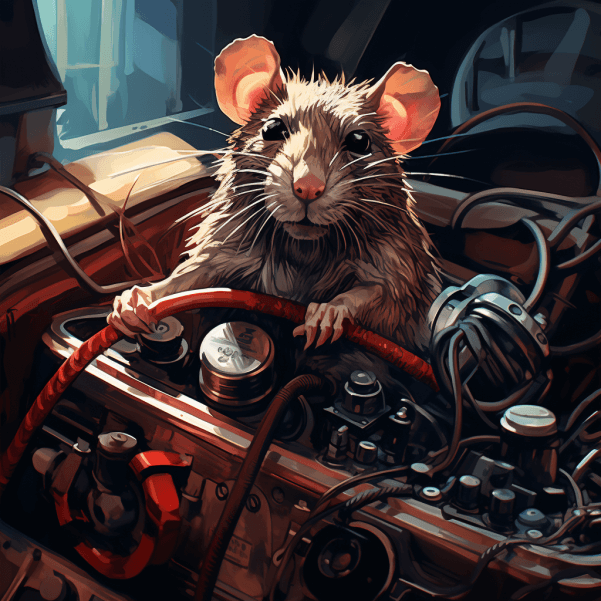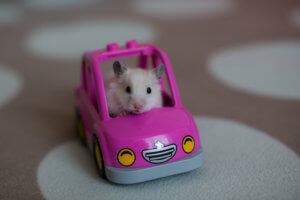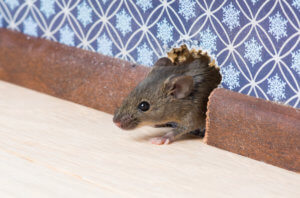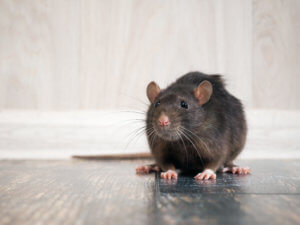

Hello fellow rodent damage victims! I want to ensure you that if you are looking for help with how to deal with rodent damage to your car, you are in the RIGHT place!
I have helped thousands of people with this problem and at one point, I was in your shoes. See My Story here.
Here are the exact steps that myself and thousands of other victims follow to prevent this problem from occurring:
How To Prevent Rats and Mice From Eating Your Car Wires
- Leave Your Hood Up At Night
- Place Tomcat Rat Traps on the Tops and Bases of the Trade of the Front 2 Tires
- Spray Grandpa Gus’s Double-Potent Rodent Repellent Spray (Peppermint & Cinnamon Oil Spray) into the Engine Compartment
- Shine Bright Lights on the Tread of the Front Two Tires
Above are the exact steps that myself and thousands of other victims follow to prevent this problem from occurring.
Now to recap each of the steps above, see below.
What you will need:
- Tomcat Rat Snap Traps (6 traps per car)
- Grandpa Gus’s Double-Potent Rodent Repellent Spray (i.e. peppermint & cinnamon oil spray)
- Bright Light (4 Flashlights or 1 Shop Light)
1. Leave Your Hood Up At Night
At the first sign of damage or rodent droppings in the engine compartment, it is essential to leave your hood up at night. You should do this for the first 1-2 weeks every night and then 2-3 times a week once you feel comfortable that there are no more rodents visiting your car. This essentially eliminates the engine compartment as a potential nesting grounds by taking away the warmth, allowing more moisture to enter, and exposing it to more light.
2. Place Tomcat Rat Snap Traps on the Tread of the Front 2 Tires
You will need 6 snap traps total and 3 will be placed at specific locations on the tread of the front 2 tires. Here is video to show exactly where to place the snap traps.
When rodents enter the car, they climb up the tread of the tires, so this essentially will block off the entrance to the car. I use the Tomcat Rat Snap Traps because they are super easy to set (i.e. I don’t feel like I am going to lose a finger when I set them), their design makes it almost impossible for a rodent to take the bait without setting off the trap, and they get the job done!
3. Spray Grandpa Gus’s Double-Potent Rodent Repellent Spray into the Engine Compartment
In the first 1-2 weeks, spray the engine compartment 3-4 times a week and then reduce to 2-3 times week once you haven’t noticed any new signs of rodents. Grandpa Gus’s Double-Potent Rodent Repellent Spray is an all natural peppermint & cinnamon oil spray that can be used to deter rodents from chewing on the wires in cars. The purpose of the spray is to confuse the rodent on the safety of the engine compartment by making it more difficult to detect the scent of their urine. As mentioned above in the enemy profile, rodents use urine as a way to mark paths, locations, food, etc., as safe.
4. Shine Bright Lights on the Tread of the Front Two Tires
As further explained below, rodents always prefer to stay concealed and hate being in the light. The goal of this solution is to deter the rodent from climbing up the tread of the tires by forcing it to walk through a spotlight to get into the car. It would be best if you laid out 4 flashlights on the ground level and shined them on the front and backs of the tread (i.e. essentially you would shine them on the snap traps that are at the bases of the tread). Alternatively, you could take a shop light and shine that under the car at night.
If you care to understand the reasoning why these solutions are suggested or are dealing with other types of rodents, please continue to read on.
There are 3 other types of rodents besides Rats and Mice that may be chewing up your car:
1) Squirrels – See article How to Prevent Squirrels From Eating Your Car Wires
2) Pack Rats – See article How to Prevent Pack Rats From Eating Your Car Wires
3) Rabbits – See article How to Prevent Rabbits From Eating Your Car Wires
Rat Behavior
Rats are habitual. They like to run along the same paths, eat at the same places (2-3 places), eat the same foods, etc. This is even true to the extent that if a rat has a normal path that typically has an object in it’s way, even if the object is removed it will still run around it as if it were still there.
Rats are very cautious. They will initially eat small chunks of a new food source to determine whether it is safe or not. They cannot vomit so they will eat a small bit first to see if they get sick. Rats will also be deterred from places/situations that are not familiar. Paths that are marked as “safe” will have signs (e.g. rat droppings, rat urine, chewed up bits of paper/objects) that the other rats can detect.
Rats are sneaky. They prefer to stay concealed/in the dark and will always prefer to run alongside a wall or under foliage/covering.
Rats pee on EVERYTHING. This is their way of marking territory, showing that food is safe to eat or if this path is safe to take, etc. Rat piss is the equivalent of an identity card. Other rats can tell information about that rat based on the pee (age, gender, size, etc.). A rat nest would essentially glow under a black light.
Rats have terrible eyesight. They rely on their sense of smell in order to determine if something is safe, and their whiskers to navigate their environment. Though they are limited by the clarity of their vision, rats can see ultraviolet light and this can help them in spotting their urine.
Rats are omnivores, meaning they will eat both plants and meats.
Rat teeth will continually grow, so they are always gnawing on objects to try and keep them at a manageable length. If their teeth get too long it can be fatal.
Rats live in colonies of 8-15 and they can reproduce 6-8 new rat babies every 22-24 days! When weather shifts or food sources are scarce, alternative shelter may be sought out.
Mice Behavior
Mice are great at hiding and therefore, prefer to stay concealed. This means that they do not like bright lights and do not like to be out in the open. Mice are thigomotactic, which means they always prefer to run along a vertical surface.
Mice generally eat plants, but are omnivorous.
Mice teeth continually grow all their lives so they constantly need to look for things to chew on in order to keep them at a manageable length. Mice will actually grind their teeth so hard that they pop their eye balls in and out of their sockets in the process.
Mice eat their own crap to acquire nutrients produced by bacteria in their body.
Mice are afraid of rats because rats will actually kill and eat them (i.e. the one god damn thing that rats might actually help us with haha).
When mice eat, they get up on their hind legs and do what’s called “Tripoding” (and no not that kind..you have a dirty mind). They use their tail for balance.
Mice use their tails to help regulate their temperature. Since there is no fur on the tail, the mouse might circulate more blood through the tail if it needs to cool down. Mice that grow up in colder environments actually have shorter tails because of this reason.
Mice mark their territory, common routes, escape routes and feeding spots with urine.
Mice leave an odor from the soles of their feet when they walk which other mice can pick up on. From this odor, other mice can tell the identity of the mouse, the direction the mouse was heading, and how long ago the mouse passed by.
Mice can give birth to new mouse babies every 19-21 days and each litter can consist on average between 6-8 mice. Each female mouse can have up to 5-10 litters per year!
Mice kill albatross babies. (this is a fact, and therefore they cannot be trusted. Look it up!)
If a pregnant female mouse comes into contact with another male mouse within the first 4 days of becoming pregnant, the female will abort the babies and mate with the new male. This is known as the “Bruce Effect“.
The nest for mice must remain to be at least 86 degrees Fahrenheit or else the baby mice might die. So, mice really need a consistently warm place in order to nest.
Now that we have a basic understanding of our enemy, we need to determine why they are taking shelter in your car.
Top 3 Reasons Why Rats & Mice Are In Your Car
1) Shelter: Especially during the winter months, rodents will leave their burrows in pursuit of warmer shelter that could also act as a potential nesting grounds. The engine compartments of cars presents an ideal location for these purposes. It is warm, dark, dry and full small nooks that could be perfect for a nesting space. If this is the case, you will see bits of shredded material in a nook or corner of the engine compartment. You will notice rat droppings as well and a black light would reveal a serious amount of rat urine.
2) Chew Toys: As mentioned previously above, rodent teeth continually grow all their lives and the engine compartments of cars can provide tons of wiring and tubing that rats can enjoy to keep their teeth at a manageable length in a concealed environment.
3) Food: Most newer cars have soy-based wiring, which can provide a nice snack for the rat. See article Does your car have soy based wiring?
Conclusion
If you really are dealing with rodent damage to your car, follow the steps at the top of the article! They are super effective!
And, if you have any questions or comments, please leave them in the comments section below. I want you to know that we are in this battle together and I can certainly be a resource for you!
We are a participant in the Amazon Services LLC Associates Program, an affiliate advertising program designed to provide a means for us to earn fees by linking to Amazon.com and affiliated sites.
Important disclosures: The author of this website is not responsible for the use or misuse of any product or similar product referenced on this website. Please follow the instructions provided with any product purchased.





